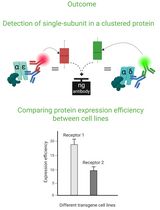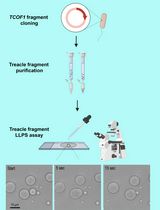- EN - English
- CN - 中文
Expression and Purification of Yeast-derived GPCR, Gα and Gβγ Subunits for Structural and Dynamic Studies
重组酵母的GPCR、Gα和Gβγ亚基的表达和纯化,用于结构和动力学研究
(*contributed equally to this work) 发布: 2021年02月20日第11卷第4期 DOI: 10.21769/BioProtoc.3919 浏览次数: 7272
评审: Sneha RayAbhinit NagarAnonymous reviewer(s)

相关实验方案

Cluster FLISA——用于比较不同细胞系蛋白表达效率及蛋白亚基聚集状态的方法
Sabrina Brockmöller and Lara Maria Molitor
2025年11月05日 1156 阅读

适用于 LC–MS/MS 蛋白质组学分析的大体积细胞培养上清分泌组样品制备方法优化
Basil Baby Mattamana [...] Peter Allen Faull
2025年12月20日 809 阅读
Abstract
In the last several years, as evidence of a surged number of GPCR-G complex structures, the expressions of GPCRs and G proteins for structural biology have achieved tremendous successes, mostly in insect and mammalian cell systems, resulting in more than 370 structures of over 70 GPCRs have been resolved. However, the challenge remains, particularly in the conformational transition and dynamics study area where a much higher quantity of the receptors and G proteins is required even in comparison to X-ray and cryo-EM (5 mg/ml, 3 μl/sample) when NMR spectroscopy (5 mg/ml, 250 μl /sample) is applied. As a result, the expression levels of the insect and mammalian systems are also difficult to meet this demand, not to mention the prohibitive cost of producing GPCRs and G proteins using these systems for a vast majority of laboratories. Therefore, exploration of an effective, affordable, and practical approach with broad applicability is demanded. Pichia pastoris expression system has shown its promise in the GPCR preparation with many merits that other eukaryotic expression systems can’t compete with. GPCRs expressed in this system are inexpensive, easy-to-manipulate, and capable of isotopically labeling. Herein, we present related protocols recently developed and upgraded in our lab, including expressions and purifications of P. pastoris derived GPCR along with Gα and Gβγ proteins. We anticipate that these protocols will advance the conformational transition and dynamics studies of the GPCR and its complexes.
Keywords: GPCR (G蛋白偶联受体)Background
G protein-coupled receptor (GPCR), the biggest membrane protein family, plays critical roles in many (patho) physiological activities. Dysfunctions of GPCRs or their effectors will result in various pathologies, including neuro-degenerative diseases, cancers, and chronic inflammations (Overington et al., 2006). Although more than 350 structures (Congreve et al., 2020) of over 70 GPCRs have been resolved in complex with ligands and/or transducins, our understanding of how the signaling is propagated through the receptor upon ligand binding to downstream signaling partners is still elusive, in part due to the resolved structures merely reflect static snapshots of the dynamics signaling processes for these complexes. In addition, limitations of the structures themselves include missing parts of flexible domains and side-chain information of many residues that were not able to be resolved in both X-ray and cryo-EM spectroscopies. The development of complementary approaches to acquire the missing information would provide invaluable insights that broaden our understanding of the sequential signaling process of the GPCRs and guide us to the discovery of drugs that target specific malfunctional signaling.
Obviously, NMR is a superb tool to interrogate the conformational transition and dynamics of the GPCRs and their signaling partners with minimal structure-function perturbation beyond static structures. In the NMR study, a wild-type or minimally modified construct is often used, which can maximally reflect the genuine behaviors of the receptor when conducted in a mimic physiological environment such as detergent MNG-3, micelle, or high-density lipoprotein particle (HDL) systems after reconstitution. The specific requirements for the NMR study also propose the challenges for a regular expression system such as E. coli heterogenous expression system. Although it is the simplest and most efficient system, the expressed proteins (especially human-derived ones) lack post-translational modifications, which often results in the loss of functionality. Insect cells such as sf9, sf21, or Hi5, and mammalian expression systems such as HEK293 and CHO cells are increasingly used for structural biology especially for X-ray and cryo-EM spectroscopic studies where a relatively small quantity of the receptors is needed. However, for NMR study, the need for a large protein quantity along with isotopic labeling makes insect and mammalian systems challenging to be employed in this type of study. Therefore, we developed a yeast-based expression system to produce receptors and their transducins meet this requirement. In this protocol, we are particularly focused on a broadly applicable strategy of preparing GPCRs, Gα and Gβγ, in which the protocol for GPCR preparation is further upgraded based on our previous publications (Ye et al., 2016, 2018a and 2018b) with a significantly improved productivity. The Gα and Gβγ preparations have been incorporated into this set of protocols as a complete system for GPCR-G protein complex study. The strategy described in the manuscript can also be applied to other signaling partners such as GRKs and β-arrestins. It is also easy to switch to isotopically labeling if needed. The advantages of expressing these receptors and effectors in the P. pastoris system are obvious in comparison with other systems aforementioned.
Materials and Reagents
1.5 ml microcentrifuge tubes (Fisher Scientific, catalog number: 05-408-130 )
2 mm electroporation cuvette (Fisher Scientific, catalog number: FB102 )
Nitrocellulose membrane (Bio-Rad, catalog number: 1620112 )
NalgeneTM Rapid-FlowTM Sterilize Disposable Filter Units with Nylon Membrane (Thermo Scientific, catalog number: 09-740-24A )
FisherbrandTM bulk-packed HDPE 7 ml scintillation vial (Fisher Scientific, catalog number: 03-337-20 )
WhatmanTM binder-free glass microfiber filters, grade GF/C (Cytiva, catalog number: 09-874-32A )
DWK Life Sciences KimbleTM solid borosilicate glass beads (Fisher Scientific, catalog number: 10-310-3 )
PuritanTM hospital standard cotton swab (Fisher Scientific, catalog number: 22-029-684 )
SartorisTM VivaspinTM 20 centrifugal concentrator (Sartorius, catalog number: 14-558-501 )
Thermo ScientificTM NalgeneTM Rapid-FlowTM sterilize disposable filter units with nylon membrane (Fisher Scientific, catalog number: 0974024A )
Slide-A-LyzerTM MINI Dialysis Devices, 3.5K MWCO, 0.5 ml (Fisher Scientific, catalog number: 88400 )
14 ml round-bottom tubes (Fisher Scientific, catalog number: 12-565-971 )
250 ml Nalgene® centrifuge bottles (Sigma-Aldrich, catalog number: Z353736 )
Pichia pastoris SMD 1163 strain (Invitrogen)
pPIC9K vector (Invitrogen)
pPIC9K_ADORA2A (Engineered from pPIC9K)
XL-10-GoldTM ultracompetent E. coli cells (Agilent, catalog number: 200314 )
BCA Protein Assay Kit (Pierce, catalog number: PI23227 )
Imidazole (Fisher Chemical edge, catalog number: 03196-500 )
EDTA (Sigma-Aldrich, catalog number: E5134 )
Glacial acetic acid (Fisher Scientific, catalog number: A385-500 )
Methanol (Fisher Scientific, catalog number: 412-500 or A412P4 )
Glycerol (Fisher Scientific, catalog number: G33-500 )
D-sorbitol (Fisher Scientific, catalog number: S459 )
G418 sulfate (Fisher Scientific, catalog number: BP6735 or Wisent Inc., catalog number: 400-130-XG )
Ampicillin sodium salt (Wisent Inc., catalog number: 400-110-EG or Fisher Scientific, catalog number: BP176025 )
LB miller broth (Wisent Inc, catalog number: 800-061-1K )
LB agar miller powder (Fisher Scientific, catalog number: BP14252 )
Yeast extract (Wisent Inc., catalog number: 800-150-IK )
Bacteriological peptone (Wisent Inc., catalog number: 800-157-IK )
Yeast nitrogen base w/o amino acid (Wisent Inc., catalog number: 800152018WG )
Dextrose (D-Glucose) (Fisher Scientific, catalog number: D16-500 )
Agar (Fisher Scientific, catalog number: BP1423-500 )
D-Biotin (Sigma-Aldrich, catalog number: 2031 )
L-histidine (Sigma-Aldrich, catalog number: H8000-5G or Fisher Scientific, catalog number: BP382100 )
DMSO (Fisher Scientific, catalog number: D1391 )
Theophylline (Sigma-Aldrich, catalog number: T1633 )
NaCl (Fisher Scientific, catalog number: S271-500 )
Bis-Tris (Fisher Scientific, catalog number: BP301-500 )
Lauryl maltose neopentyl glycol (MNG-3) (Anatrace, catalog number: MG310 )
Cholesterol hemisuccinate (CHS) (Sigma-Aldrich, catalog number: C6512 )
Talon Metal Affinity Resin (TaKaRa, catalog number: 635503 )
(Optional) Liquid Nitrogen
BamHI-HF (New England BioLabs, catalog number: R3136S )
NotI-HF (New England BioLabs, catalog number: R3189S )
PmeI (New England BioLabs, catalog number: R0560S )
T4 DNA ligase (New England BioLabs, catalog number: M0202S )
Quick CIP (New England BioLabs, catalog number: M0525S )
GenEluteTM Plasmid Miniprep Kit (Sigma-Aldrich, catalog number: PLD35-1KT )
100% ethanol (Fisher Scientific, catalog number: A4094 )
HRP-conjugated 6*His, His-Tag Monoclonal Antibody (Proteintech, catalog number: HRP-66005 )
DDDDK TAG Polyclonal Antibody (Equivalent to FLAG® Antibodies) (Proteintech, catalog number: HRP-20543-1-AP )
Zymolyase-20T (Amsbio, catalog number: 120493-1 )
Xanthine amine congener (Sigma-Aldrich, catalog number: X103 )
Affi-GelTM 10 (Bio-Rad, catalog number: 1536099 )
Isopropanol (Fisher Scientific, catalog number: A426P-4 )
Antifoam A Concentrate (Sigma-Aldrich, catalog number: A5633 )
Thermo ScientificTM Yeast DNA Extraction Kit (Fisher Scientific, catalog number: PI78870 )
Thermo ScientificTM Y-PERTM Yeast Protein Extraction Reagent (Fisher Scientific, catalog number: PI78991 )
Universal-ES liquid scintillation cocktail (MP BiomedicalsTM, catalog number: 88248001 )
3,3’,5,5’-tetramethylbenzidine solution (Alfa Aesar, catalog number: J61325 )
PageRuler Plus Prestained Protein Ladder (Fisher Scientific, catalog number: 26619 )
BioAcryl-P (30%, 29:1) liquid (Alfa Aesar, catalog number: J63279 )
QIAquick Gel Extraction Kit (Qiagen, catalog number: 28704 )
10× Phosphate buffer (see Recipes)
Immunoblotting Blocking buffer (see Recipes)
Immunoblotting Incubation buffer (see Recipes)
Immunoblotting Washing buffer (see Recipes)
LB plates (see Recipes)
YNBD plates (see Recipes)
YPD medium (see Recipes)
YPD agar plates (see Recipes)
BMGY medium (see Recipes)
BMMY medium (see Recipes)
Common Washing Buffer P1 (see Recipes)
Receptor Lysis Buffer P2 (see Recipes)
Receptor Preparation Buffer P3 (see Recipes)
Receptor Preparation Column Washing Buffer P4 (see Recipes)
Column Elution Buffer P5 (see Recipes)
XAC Column Elution Buffer P6 (see Recipes)
G Protein Washing Buffer P1 (see Recipes)
G Protein Lysis buffer P2 (see Recipes)
G Protein Elution Buffer P3 (see Recipes)
Q Buffer A-Gα (see Recipes)
Q Buffer B-Gα (see Recipes)
Q Buffer A-Gβγ (see Recipes)
Q Buffer B-Gβγ (see Recipes)
Immunoblotting Blocking Buffer (see Recipes)
Immunoblotting Washing Buffer (see Recipes)
Radioligand Binding/Washing Buffers (see Recipes)
Equipment
(Optional) -80 °C freezer
Thermo ScientificTM SorvallTM Centrifuge (Thermo Scientific, model: ST 40R )
EppendorfTM Microcentrifuge (Eppendorf, model: Legend Micro 21R )
Applied BiosystemsTM SimpliAmpTM Thermal Cycler (Applied Biosystems, model: A24812 )
GenesysTM UV-vis spectrometer (Genesys, model: 10S )
Thermo ScientificTM Heratherm Microbiological Incubator 117L (Thermo Scientific, model: IGS100 )
NanoDropTM spectrophotometer (NanoDrop, model: Lite )
ÄKTApurifier FPLC (GE, model: Purifier 100 )
Cell electroporation system electroporator (Bio-Rad, model: Gene Pulser X )
FisherbrandTM Heavy-Duty Vortex Mixer (Fisherbrand, model: STD )
5 L New Brunswick bioreactor (New Brunswick, model: BIOFLO III )
MicrofluidizerTM Processor (IDEX Material Processing, model: LM20 )
Procedure
文章信息
版权信息
© 2021 The Authors; exclusive licensee Bio-protocol LLC.
如何引用
Zhao, W., Wang, X. and Ye, L. (2021). Expression and Purification of Yeast-derived GPCR, Gα and Gβγ Subunits for Structural and Dynamic Studies. Bio-protocol 11(4): e3919. DOI: 10.21769/BioProtoc.3919.
分类
生物化学 > 蛋白质 > 分离和纯化
生物化学 > 蛋白质 > 表达
生物物理学 > 核磁共振波谱法
您对这篇实验方法有问题吗?
在此处发布您的问题,我们将邀请本文作者来回答。同时,我们会将您的问题发布到Bio-protocol Exchange,以便寻求社区成员的帮助。
Share
Bluesky
X
Copy link









